I recently tried on a pair of “Frankenstein” jeans. Their high waist and uneven, frayed hem horrified my husband, who managed to mutter “mom jeans” under a fake cough while slowly shaking his head when I emerged from the change room. Despite his less-than-enthusiastic reaction, I still bought them—partly because I liked them and partly because Instagram told me to.
Let me rephrase that: I have free will and I am capable of making my own decisions; however, after months of scrolling through my feed and seeing pic after pic of my style crushes Miroslava Duma and Eva Chen wearing versions of the polarizing denim, I wanted a pair too.
Social media’s echo chamber is real, says Bhupesh Shah, professor and coordinator of the social-media program at Toronto’s Seneca College, noting that even though we have access to 2.8 billion social-media users around the world, we tend to gravitate toward the feeds of like-minded individuals. “If you’re in an echo chamber, what’s reverberating is going to influence the way you think,” he says. Sounds obvious, but by sharing and liking similar posts, our tastes, ideas and beliefs are reinforced through repetition, consequently creating a social bubble.
My feed is the textbook definition of said bubble: I mainly follow folks in the fashion industry known for pushing the sartorial envelope. This means I’m disproportionately exposed to super-stylized images and not-so-mainstream trends that, after seeing them over and over again, suddenly start to look and feel, well, normal. Case in point: the Vetements Frankenstein jeans, which debuted on the label’s spring/summer 2015 runway. Initially, I wasn’t blown away, yet they now hang in my closet. Coveting a pair of admittedly fashionable but questionably flattering jeans isn’t so far-fetched when it feels like almost every person in my feed has a pair.
I’m not the only one letting social media make my style decisions. A recent survey by Instagram analytics platform Dash Hudson revealed that 87 percent of influencers look to their social-media feeds to inform their purchasing decisions. And one-third of Instagram users have bought a piece of clothing they first peeped while surfing the social-networking app. By relying on our screens and the passive act of scrolling instead of actively searching for new wardrobe ideas, we may be limiting our creativity and style intuition. If we are all just emulating one another, do we run the risk of losing our personal sense of style or, worse, becoming fashion clones?
The technology behind certain social-media platforms makes it even easier to stay in our bubble. “Algorithms look at the things you’ve clicked on in the past and, based on that, recommend new things to you,” says Alex Krasodomski-Jones, a researcher at the Centre for the Analysis of Social Media at the U.K.-based think tank Demos. We leave behind a trail of data “bread crumbs” every time we “heart” a Gucci Marmont bag or give Kylie Jenner’s latest lip kit the thumbs-up. Instagram, Twitter and Facebook use this data to personalize our feeds and tailor the type of content we see to reflect our past preferences, which amplifies it all. Differing ideas, styles and viewpoints often get filtered out.
Algorithms also tend to favour the loudest voices—that is, posts with the most likes. The more popular a post, the more often it appears on a feed with likes begetting likes. Depending on its marketing strategy, a brand can either win big or lose big on social.
It’s not only who we’re seeing online that is affected; it’s also the type of trend. Minimalism seems to have no place in the age of the selfie. “Peacocking,” or posing in over-the-top pieces, gets maximum attention. Calgary-based style blogger and Instagram star Ania Boniecka, who has 113,000 followers and climbing, treats her posts like a magazine editorial and seeks out items that she knows will photograph the best. “If it’s just a plain outfit, like a T-shirt and jeans, to me it’s boring,” she says.
Fashion designers have started to recognize this vivid medium and are responding to it. “Sometimes, I have to admit, as a designer, you get into this trap of thinking about clothes for a picture rather than what’s going to go into the market or showroom,” Alexander Wang told The New York Times in 2014. Or, as Jeremy Scott succinctly put it in The New Yorker: “You only have a screen that is this big [the average smartphone is about 12 centimetres] to make an impression.”
Making that impression doesn’t mean you need to rethink your style to be more Moschino than minimalist; nor do you have to burst your social bubble just yet. If our understanding and interpretation of fashion is compromised when our scope is limited, we simply need to let a little air in. “It’s a good feeling to find people who agree with us,” says Krasodomski-Jones. “The problem is when you aren’t conscious of the fact that your world view is being narrowed.”
Shah suggests conducting your searches using more general hashtags—like #ootd and #streetstyle—instead of specific trends or brands. Follow people you disagree with (this is known as “hate-following”) or those whose style is a far cry from your own. This will not only open your eyes to new ideas and trends but also keep those algorithms guessing.
As for me, I admit it feels quite cozy inside both my bubble and my Frankensteins. But I now know who created them. The next time I go shopping, it won’t be my screen (or my husband) that offers me validation. I’m going with my gut.
From: Elle Canada


